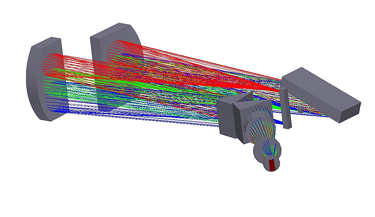The Hermes Echelle Spectrograph
 The main driver for this instrument is stellar physics covering a broad range of applications going from complementary characterization of targets observed in space to fundamental parameter and abundance determinations of a large diversity of individual stars in all evolutionary stages as well as the (long-term) monitoring of the radial velocity of variable stars and binary or multiple systems. HERMES is a high-resolution spectrograph which records the optical spectrum in the range lambda = 377-900 nm across 55 spectral orders in a single exposure (fig. 3). Its spectral resolution is 63 000 in the LRF mode and 85 000 in the HRF mode.
The main driver for this instrument is stellar physics covering a broad range of applications going from complementary characterization of targets observed in space to fundamental parameter and abundance determinations of a large diversity of individual stars in all evolutionary stages as well as the (long-term) monitoring of the radial velocity of variable stars and binary or multiple systems. HERMES is a high-resolution spectrograph which records the optical spectrum in the range lambda = 377-900 nm across 55 spectral orders in a single exposure (fig. 3). Its spectral resolution is 63 000 in the LRF mode and 85 000 in the HRF mode.
 It is located in a thermally controlled room with wall re-enforcement against large pressure fluctuations. Advantages of the instrument are its broad spectral coverage, high stability (it has a long-term velocity stability of 50 m/s) and excellent throughput (Raskin et al. 2011, A&A 529, 69).
It is located in a thermally controlled room with wall re-enforcement against large pressure fluctuations. Advantages of the instrument are its broad spectral coverage, high stability (it has a long-term velocity stability of 50 m/s) and excellent throughput (Raskin et al. 2011, A&A 529, 69).
 The HERMES Consortium is a partnership between the KULeuven, the Université Libre de Bruxelles and the Royal Observatory of Belgium with contributions from the Observatoire de Genève (Switzerland) and the Thüringer Landessternwarte Tautenburg (Germany). Astronomers from the partner-institutes perform 10-11 days campaigns of spectroscopic observations with HERMES on a regular basis.
The HERMES Consortium is a partnership between the KULeuven, the Université Libre de Bruxelles and the Royal Observatory of Belgium with contributions from the Observatoire de Genève (Switzerland) and the Thüringer Landessternwarte Tautenburg (Germany). Astronomers from the partner-institutes perform 10-11 days campaigns of spectroscopic observations with HERMES on a regular basis.